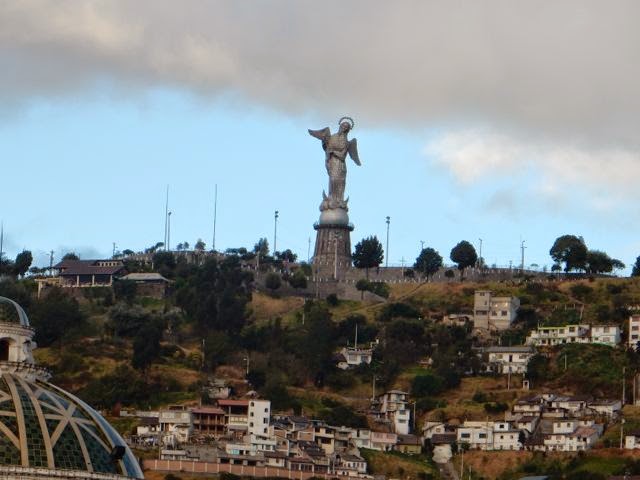 |
| Virgin de Quito with Wings |
 |
| Eating in High Places |
By pickup truck, boat, plane, SUV, it took a day to get from Galapagos back to Quito and our friendly and elegant hotel Plaza Grande overlooking the main plaza of the city. From the afternoon arrival Quito’s very contemporary new airport, traffic jammed as it always did to cross a one-lane bridge (like pouring a sack of coffee beans into a thimble) and to beat the snake-like curves and bottlenecks that make the trek from the airport tedious. Tired as we were as darkness turned on the city lights, we were able to get to the Restaurant in the Theater National not far from our hotel – a 2nd floor dish of red, white and black, and one of the best meals of my life: tuna tartar with salsa; shrimp ceviche in a broth of tomato and orange; and then the tester dessert of passion fruit cream and sorbet and white chocolate cream and parfait – all tiny helpings. We fell into comfortable beds – finally.
 |
| Dessert to scream for |
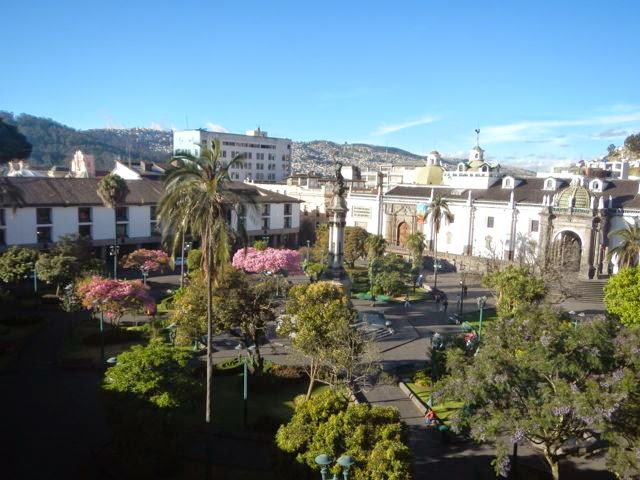 |
| Across the Plaza |
Morning came with the usual town bell ringing softly about 6:15 and then loudly and continually at 7 a.m. Got out of bed too fast, Uh-oh – we forgot about the high altitude we had returned to – about 2800 meters high or 9000 feet. The bells tolled probably for morning mass, as there are major Roman Catholic churches in every direction and attending mass is a daily discrepancy for the Ecuadorians. Directly across the palm-filled Plaza Grande from our hotel is the RC Cathedral, with its gold rooster on top of the cupola, where in 1877 Archbishop Checa y Barba was poisoned by communion wine laced with strychnine, and right under the statue of the Winged Virgin of Quito, or the Dancing Madonna, who has been given silver apocalyptic angel wings (for escape) as she stomps on a serpent (the bad guy, Satan, with the apple of original sin in his mouth) and protects the city. She has the facial features of a Mestiza (mixture of Spanish and Inca Indian). There is no oversleeping in this town. By 7 a.m. the shoe-shiner had set up his
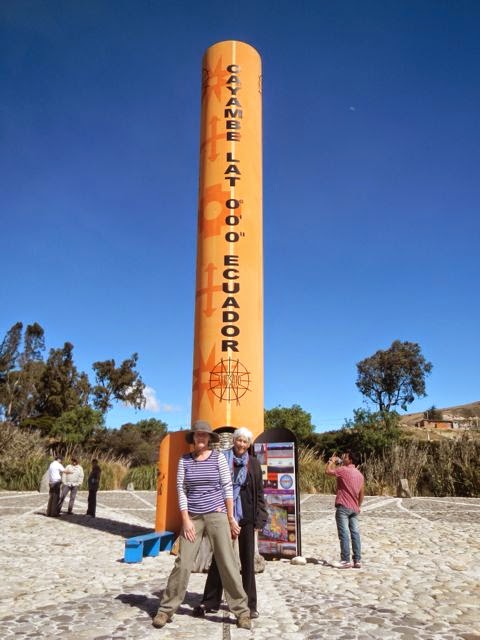 |
| Standing on the Equator |
chair, the tired old Mestiza lady in a thick blue sweater and a green man’s cap yelling shoe-strings for a dollar, and we were finishing up a spicy hot chocolate or a large cup of coffee in the dining room.
We had a full day scheduled and it entailed a stop at where the equator crossed the road, a derive to Lago de Saint Paul to get to the famous Oldavaldo Market (about 3 hours from Quito), and lastly, visit a family of weavers.
The miracle of the equator is amazing. We were standing on Monte Catequilla at Latitude 00”00’00” and Longitud Oeste 78” 25’42”, smack in the middle of the Quitsato or the Middle of the World. The concept is so precise because at the Equator (which means “equal), everything is the same 365 days of the year – the temperature is a
 |
| Expert on Equatorism |
perfect 15 degrees Celsius and up the Equator from where we stood is Mt. Cayambe (5719 meters) which is the only mountain with snow along the equator’s entire 40,000 kilometers. Chimborain, 6310 meters, is the tallest mountain on the equator. Mary and I stood on the line marked in cobblestones, she leaned to the south, I leaned to the north. And then a young scholar in the studies of the equator and its history gave us a presentation. Much research is being done by Ecuadorians. It was the equator that proved the world was round. He said, for too long, it had been a toss up of whether it was shaped like an American football or an orange. Take one degree of the meridian and multiply times 360 and you get the circumference. It took eight years to measure it and the equator is a bit over 40,000 kilometers and the longitude line through the North and South poles is somewhat less than 40,000 kilometers, which means the earth, like many of us, is fatter than it is taller. Measuring the equator is also how the metric system began: one meter is ten millionth part from the equator to the pole. It gets complicated. But where we were standing was a large circle (all of cobblestones) with various lines indicating positions of the sun at certain times of the year and day. When the sun rising and setting seems to move across the sky by many degrees, it’s always the same on the equator, and to boot, it’s how the earth revolves around the sun.
We had to push on through the extraordinary rose farming country, obvious by the giant plastic greenhouses across the rolling land. The best place in the world to grow roses is right on the equator in Ecuador’s Cayambe Valley – and this is
 |
| At Otavado Market |
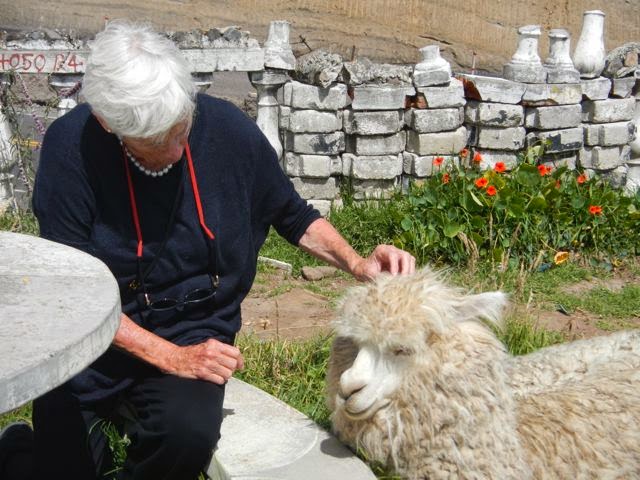 |
| Llama bonding |
why their roses have very sturdy straight stems. Flowers follow the sun and here the sun is always straight overhead. Also 85 per cent of the workers in the rose industry are women. When men went to the city for better labor, they left families behind. And when the rose industry began to blossom, women were the ones hired and it now brings in more then 500 million dollars a year. Consequently there are many divorces as women will not follow their husbands into the city and no longer need them for support. The Rose industry is fourth in Ecuador after oil, bananas and flowers in general.
Weaving through mountains and valleys to reach the famous Otavado Market, the largest in Ecuador, we stopped by a “tourist trap” to sample a “biscuit” ( a dried piece of dough which is cooked twice gussied up by a bit of dulce de leche.) and take a photo with a llama who looked like he hadn’t moved in a decade. When we reached Otavado Market, it was spread down a number of streets and packed with fabrics and crafts and clothing and painted pots and enameled chess sets and giant wooden spoons. We failed at bargaining, in general because prices seemed cheap to us. Bargaining doesn’t seem so fair for the poor men and
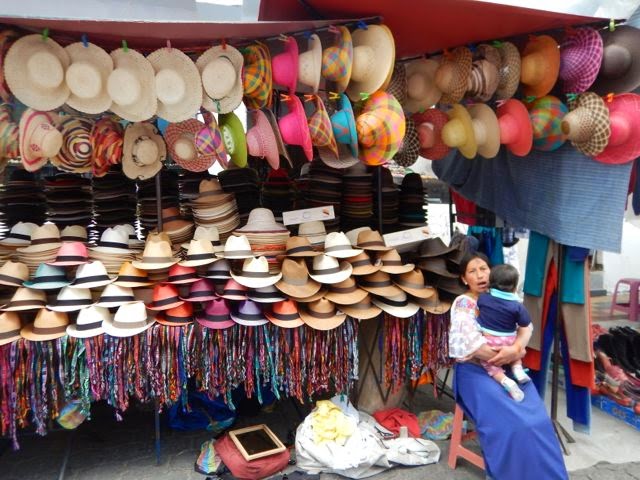 |
| Panama hats made in Ecuador |
 |
| Fried Pig parts |
women who spend the hours to hand sew or weave or crochet or paint their products. We bought hammocks, alpaca scarves, crocheted bags, blankets all of which seem to repeat themselves booth to booth. Were they by hand or machine? I’m no expert. There were booths selling Panama hats (which are made not in Panama but in Ecuador only) and white puffed sleeve blouses embroidered with flowers (so many they surely must have been machine-made.) Best – all transactions in Ecuador are in dollars – and, while remembering it, Ecuador is in the same time zone as Memphis. No jet lag.
The food market confirmed what we had figured – potatoes are THE food in Ecuador – but there are 150 kinds of potatoes,
 |
| Peas and Beans at Market |
 |
| Yarns for sale |
and each has a different purpose. Corn is second in favor. For lunch I had a locro or potato soup made with 3 kinds of potatoes and one little one tasted just like beet. In the market: lots of peas ad beans, and exotic fruits, and jellies sold in tiny cups, 10 to a sack. We stayed away from street food and the little cafes with giant portions of pig heads and skin that had been deep fried. But we saw the best looking broccoli I’ve ever seen and learned that it is a major export to the US. There are not a lot of sweets, but plenty of corn nuts and other peanuts peddled on the streets. Tree tomatoes and guyabana fruits and caca de perro (dog poop peanuts, caramelized) are offered. We had to get out of there and our bags were getting heavy.
 |
| backstrap weaving |
As a special ending to this day trip, we were taken to the home of a family of weavers, which is three stories of their hand-made products from belts to the finest of bedspreads that take 2 and a half months to complete one because it’s done on a backstrap loom. The matron of the family explained to us about natural dyes and how tiny bugs that thrive on cactus (cochiniles) when
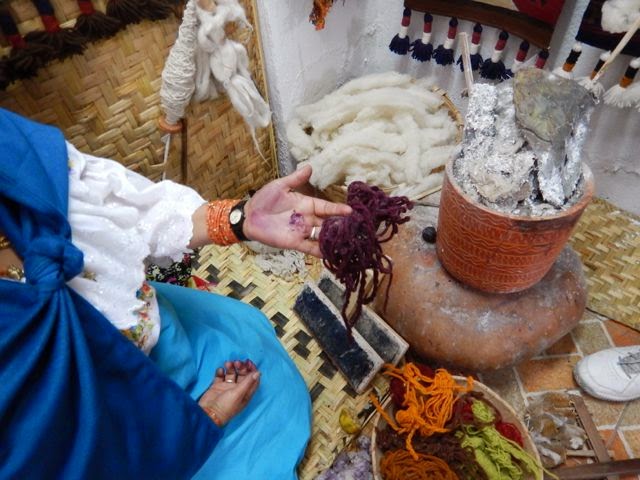 |
| Natural dyes |
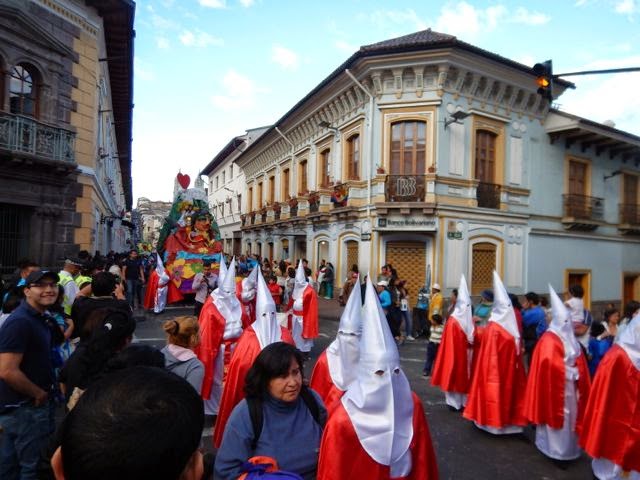 |
| Cucucruchos in parade |
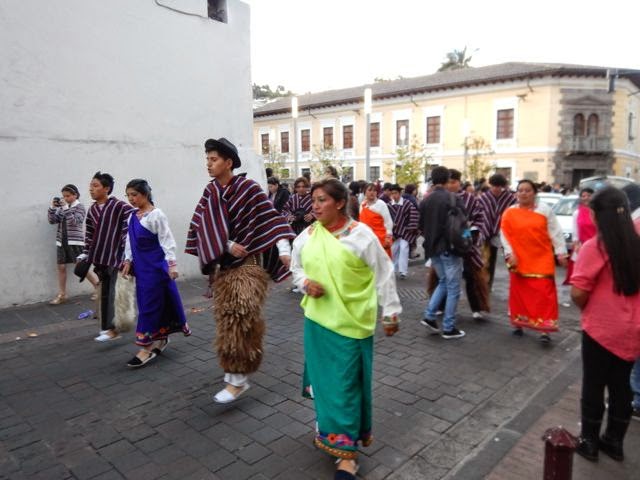 |
| Los Chagras dance |
squashed make a red dye then if lemon is added to it, a copper color, and if bicarbonate of soda, a sharp purple; walnut hulls turn wool brown, and a plant called chilka turns it lime green. But, the matron admitted, she buys most of the yarn in the marketplace. She showed us the physical strain of working long hours on the backstrap loom, sitting on the floor, counting threads in a complicated pattern. And there were many old style looms to make so many of their products. Her entire family participate in the business and they do not sell their products at the market.
It was a two hour marathon drive around curves and between mountains to get us back to Quito. The hardest part of this trip is we spend most of it getting places in thick traffic or on difficult terrain. On return, we could not get to our hotel because there was a special parade in honor of “Jesus de Gran Poder” (Jesus the Almighty), and his picture was painting on the lead car. There were crude floats and dancing youth, and stilt walkers and the presence of the cucurucho penitents in white satin or red pointed hoods that disturbed me as they reminded me of the KKK. (usually the cucurucho dress in purple and look like monks carrying a cross or a candle. This is a secret society which is
 |
| We love a Parade! |
in penitence and is helping others to be penitent for their sins and errors.) The “disfile” or parade honor each July 19 honors the pride of the Ecuadorian cowboys or Los Chagras of the Andes, who tend fields and cattle in the highlands. The young chagras wear ponchos, chaps, spurs and boots to dance down the street. When Mary and I reached our third floor room with balcony over the plaza, it sounded as if the entire parade was in our room, but we enjoyed the moment and did a little dance ourselves, or rather Mary did. A good day today.

















